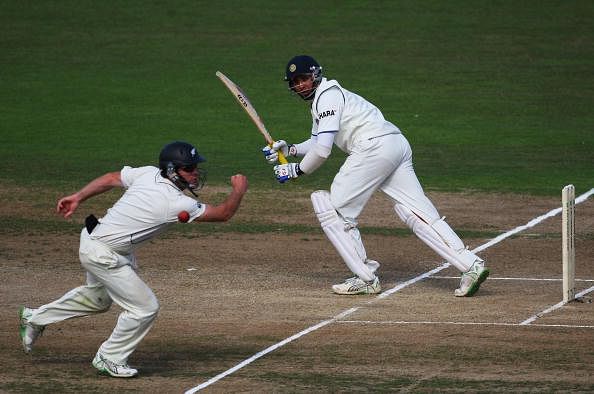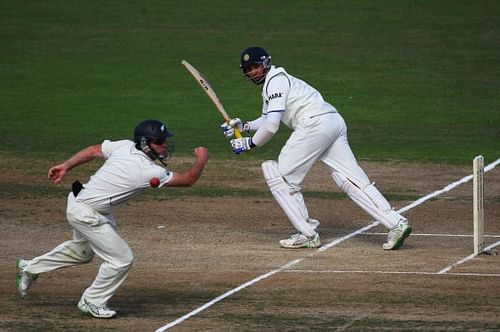
VVS Laxman: Subtle and elegant!

When the dasher is dazzled, when the wall is shattered, when the master is mastered, when the fighter is defeated, there remains a force, an ubiquitous force that mastered, shattered, dazzled and defeated the opponents with an obtuse elegance of his own, wielding the bat like he pleased, seldom caring about field placements, for the ball that meets the middle of the bat ends up being retrieved from the boundary by a grumpy fielder who would be expecting the ball to come his way, only to be disappointed by the absolute and impeccable timing of VVS Laxman.
Laxman, the under-rated performer of the fab four, has carved a niche for himself in the longer format. He has a unique pair of supple wrists that is the exclusive property of Hyderabad, having already witnessed the likes of Mohammad Azharuddin and Gundappa Vishwanath patenting it in the past. Laxman was no different. He would pick the half-volley and while the bowler would be expecting him to hit it through the covers, he would surprise them by allowing the ball closer than any other batsman actually would and use his rubbery wrists to find the gap between mid-on and short mid-wicket for a boundary.
The speciality of Laxman is the ease with which he plays against the fast bowlers. He is never perturbed by the rising deliveries; rather, he would relish the opportunity to combat the bowler emerging as the winner. An Indian relishing fast bowling was an odd sight but it was all the more pleasing to see Laxman latch up to the bowlers, playing some crisp strokes against them irrespective of the conditions.
Laxman was an extremely efficient player against spinners and has acquired all the shots in the book. He was well-known for his shots against spin, which were considered his trademark. Laxman is a batsman who would appear to the bowler as though he is vulnerable, trying to play the flick every now and then. The bowler’s hopes would rise and he would be like “Okay, he is trying to play the flick, let me bowl straight and at the stumps, he would try and flick me and get out Leg before wicket!” It would seem pretty straight forward to him and he would be imagining that he was a hair’s breadth away from picking the wicket. But what he fails to understand is Laxman can play that flick no matter where you bowl at him or how good you bowl at him. He would keep finding the boundary a hundred times out of hundred.
Such was his precision that the actual ‘hair-breadth distance’ would actually be distance between the earth and the sun; a bowler falls in on that illusion and loses himself in some out-of-the-world shot-making. Laxman had a subtle arrogance about himself not allowing the pressure get to him. His credibility as the finisher in tests is unparalleled and the solidity and depth he lent to the Indian middle order proved vital in stamping our authority in international cricket.
Any tribute to Laxman would be nigh impossible without talking about his mammoth 281 runs that he plundered against Australia in the Border-Gavaskar trophy in 2001. Steve Waugh’s team, after having a dream run, came to India hoping to conquer the ‘final frontier’. It was perceived to be a battle among unequals, with India fielding a young and inexperienced side.
Australia dominated as expected and for a moment, it seemed like they were indeed going to run away with the series, thereby establishing their dominance all over the world. They won the first Test comfortably and were on the brink of victory in the second Test, when Laxman turned it for Team India. The Australians were at a loss for an answer to Laxman’s stroke play.
Things were quickly turning upside down. Laxman was at his elegant best; he was full grace and poise, cutting and swerving against the hostile fast bowlers. He treated them with a queer arrogance and Waugh, at the end of the day, commented “Where do my bowlers bowl to him?!” Laxman was simply unstoppable and he created history at Eden Gardens
It is not all about Laxman. He was a master at guiding the tail-enders, an unenviable task which he has taken up through the years. He played along with the lower order batsmen, acting as a shield and yet managing to score valuable runs down the order. Maybe that is why Laxman did not have too many hundreds in Test cricket, but being the down-to-earth person, he has never complained about it once or bothered about his numbers.
Laxman is a player who learns from his mistakes and quickly at that. He matured a lot as a player and his hey days were surprisingly the last five years before 2011 happened. He was as sweet as a ripe fruit and his form meant that India’s batting looked solid and stable. He played some crucial knocks against Sri Lanka in 2010 in the series where Suresh Raina made his debut. He, along with Raina, was responsible for the 1-1 result and without Laxman’s contributions, India would have surrendered their number one ranking.
It was the same against the visiting Australians. He guided the tail-enders to seek a last wicket victory against Australia and was hugely responsible in that series victory. He was visibly pumped up, a rare sight which demonstrated how much a victory means to the man.
Laxman signified the good virtues that any aspiring cricketer should possess. His calm and decent attitude was worth a salute and the silence only signified something vociferous in his own unique style. He is a phenomenon in Indian cricket, and a role model to any cricketer who is ready to look ahead of the Tendulkar’s and the Dravid’s of Indian cricket.
His only qualm was missing the world cup it would certainly not be fulfilled after hanging up his boots last year. It was pretty woeful that he had to miss the world cup berth, but cricketers are not reel heroes – they do not get all the good in the world. Rather, they have to be content with what they have. In that regard, VVS Laxman was a warrior, an undying warrior who was ready to lay down his life for the betterment of Indian cricket. Losing him, along with Rahul Dravid, was a curse for India, but he was a hero to me, and a true Indian at heart. Take a bow VVS!